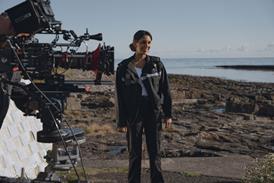Visitors to the IBC exhibition reveal the eye-catching hi-tech products creating a buzz among buyers and shaping the future of broadcasting.
Gareth Wilding
Sales and marketing director, Fineline
Acquisition seemed to be at the forefront of everyone’s minds at IBC, with plenty of new cameras and camera developments. Sony’s impressive F65 has an attractive price point of probably half the cost that people expected when it was first discussed at NAB earlier this year. It had authorised resellers and film industry prospects buzzing, and it’s bound to establish Sony in the top-end drama and feature sector.
However, it has stiff competition from Arri’s popular Alexa, which is smaller and lighter. For top-end 3D work, the ‘M’ configuration, with detachable heads each weighing less than 3kg, looked brilliant. Also popularn on the stand was the Alexa Studio model with its mirrored shutter and optical viewfinder.
Panasonic’s hand-held HPX- 250, which records at up to 100Mbps and has a variable frame rate and 22 x zoom lens, will prove popular. The company also announced the re-introduction of studio camera channels for the European market.
Sony and Panasonic both featured shoulder-mounted 3D camcorders. Sony announced the first sales of its TMW-TD300 to Presteigne-Charter, and Panasonic has been working with a major broadcaster on its AG-3DP1, which will be used extensively at the London 2012 Olympics.
Other eyecatching pieces of kit included the Hi-Motion camera system from NAC Image Technology, and JVC’s 4K handheld and Meduza’s 4K 3D cameras.
Chopper Harris
Director, Root6 Technology
Manufacturers showcased new features for existing products, but there was nothing revolutionary. The show broadly centred on two themes: automation and operational efficiencies.
There were tools for accelerating aspects of workflow and, as ever, the industry’s insatiable demand for storage attracted new vendors to the show, creating a multitude of configuration options and potential for further confusion.
Significant new products arrived with web services to facilitate integration along with compatible media formats, and this was very much defined by AJA’s support of Avid DnxHD on its Ki Pro Mini.
It is clear that the cloud will have a major impact on the industry. The likely impact is still being defi ned but the emergence of cloud-based solutions from vendors such as Avid and Forbidden Technologies, together with a plethora of back-room conversations and NDAs, confirms the need to take the issue seriously.
Peter Savage
Managing director, Azule Finance
It was interesting, but also disconcerting, to see so many big manufacturers looking ahead and focusing on the next six months to a year. There were new products and a load of glass cases containing extremely exciting kit, but you simply couldn’t get your hands on it and many products were not available for purchase.
JVC’s prototype 4K camera caught my eye and the results seem to be astounding for such a small camera. It contains the world’s first LSI chip for speedy processing of HD and caused a storm on the market floor.
Sony’s aggressive pricing of the F65 also makes it incredibly attractive for dealers and cameramen to invest in for 4K acquisition, especially with the package that includes SR memory decks and cards.
The ability to record up to an hour of full-HD footage in one shoot, and ingest at 5.5Gbps, will be increasingly important as image quality increases and file sizes explode. This signals yet another big nail in the coffin for tape.
Jamie Allan
Post-production specialist, Jigsaw Systems
IBC had a lot of great new products on show that we’d been promised at NAB earlier this year. Thunderbolt seems to be maturing quickly, with Blackmagic and AJA flaunting their shipping models of the Ultrastudio 3D and IOXT, both providing small footprint I/O for Thunderbolt-enabled machines.
We’ve also seen some exciting Thunderbolt-based expansion products from Sonnet, Magma and mLogic. In particular, the 1U MacMini expander from Sonnet has given us some exciting ideas about how to utilise both the Thunderbolt port and PCIe expansion slot on the unit. We can see some cost-effective server, ingest and encoding solutions being built around this in the coming years.
Blackmagic came good with its DaVinci Resolve 8.1 update with fixes and new features that our customers have been waiting for. From a workflow side, we’ve now got solid round-trip workflow with AAF export, and the import has been improved on XML and AAF with effects and resizing coming across from the relative NLEs.
I tried the technology preview of Resolve on a Windows system and it seemed solid for something Blackmagic expects to work on for another year. When it does launch, it will give more expansion possibilities and a larger target market for the ever-improving colour grading platform.
Dan Wheeler
Managing director, PEC Video
Blackmagic had some cracking stuff but the real standout product, which we will invest in at some point, was its ATEM production switcher.
It’s a modular system, but its cheapest configuration is 695 (£604). It can turn Apple Mac computers with Thunderbolt into a production switcher capable of HD and SD with a preview and playout monitor.
Until Thunderbolt came along, you couldn’t marry the technology, but now data rates are such that you can use an Apple Mac screen and keyboard and plug in a fully-fledged switcher box. For a lot of our customers dipping their toe in the water, it’s a great introduction to live event video.
One of the smallest stands, but one of the busiest, was Floatcam, which had a dolly crane with a linear track slider for a smooth tracking shot. It was beautifully engineered and, by adjusting a few components, it transforms into a crane or jib.
JVC also had an interesting prototype of a 4K camera that might be launched before, or possibly at, NAB. Equipped with JVC’s own chip, which an produce a 4K image, it was tiny but the price - around £4,500 - was one of the exceptional features.
Danny Dawson
Hire manager, Alias Hire
With Sony’s new flagship camera, if you’re shooting a drama, feature film or high-end promo, you have three options: Red, Alexa and now the F65. It looks like it might need a bit of an assembly on set but there’s no doubt about it, in terms of digital cinema, it’s a true competitor to that range.
I was also impressed with JVC’s 4K camera. It’s modelled on its previous GM-100 and shoots to 4K by merging four 1K images. It’s a bit cumbersome in that you have to use JVC’s software to ingest four separate times to get one image, but the results are outstanding.
Sony’s new OLED monitor was pretty impressive and was a real step forward and away from CRT technology, but there is still some way to go as it struggles with 24p footage. We feel it is best used for TV grading rather than feature work. Of course, the only images we saw were the ones that Sony was showing.

























No comments yet